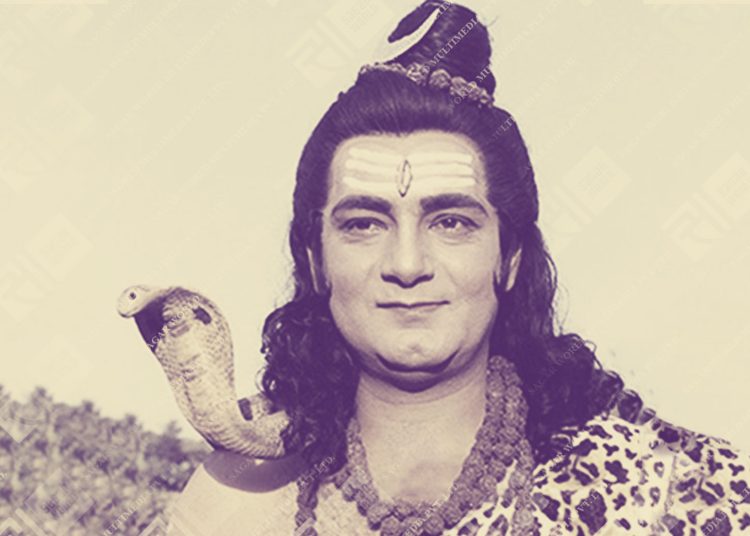(Other names : Shiv, Mahesh, Ashutosh, Neelkanth, Pinakin, Nataraj)
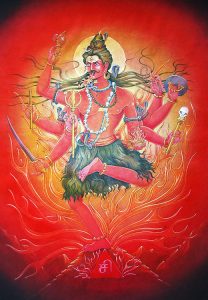
 The Hindu Trinity is Brahma, Vishnu and Maheshvara. Maheshvara is a title of Lord Shiva. “Shiva” means “the Auspicious” and the one who does welfare. Shiva is considered to be a supreme God who neither has a beginning nor end.
The Hindu Trinity is Brahma, Vishnu and Maheshvara. Maheshvara is a title of Lord Shiva. “Shiva” means “the Auspicious” and the one who does welfare. Shiva is considered to be a supreme God who neither has a beginning nor end.
He is also known as ‘Shankar’ and also the destroyer of the universe. This implies a certain amount of violence and the name of ‘Rudra’ which is the angry form of Shiva. Shiva’s basic nature is ‘Tamas’ which means anger.
It is through this angry quality that he is known to be the destroyer God (one who destroys the universe) and is prayed to by repeating ‘NAMASTE RUDRA MANVATE’ which means ‘Angry God please cool down’. His appearance is wonderful.
Shiva has Ganga flowing out of his matted hair, he wears the moon as a diadem on His forehead in the centre of which is his third eye. He has a snake coiled around his neck and he wears a garland of skulls.
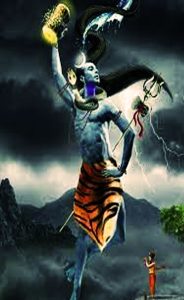
While holding His double headed tabor in his hand and is gray with graveyard ash all over His body.
Parvati sits on his left. Ghosts and Goblins are in his following, and a bull, Nandi, is his vehicle.
It was lord Shiva who took the Halahal poison to Himself when it arose after the ocean had been sufficiently churned by the Devas and the Daityas.
 He scooped up that poison which was the first thing that was produced from the ocean during Samudra-manthan (churning of ocean), and drank, but did not swallow it, and this caused His neck to turn dark blue, and that is why he is also known as ‘Neelkanth ‘(the Blue-Necked).
He scooped up that poison which was the first thing that was produced from the ocean during Samudra-manthan (churning of ocean), and drank, but did not swallow it, and this caused His neck to turn dark blue, and that is why he is also known as ‘Neelkanth ‘(the Blue-Necked).
As Shiva is easy to please, he has earned the name ‘Ashutosh’. His weapon is the trident (trishul) and the bow called ‘Pinak’ and so he is also called’ Pinakin’. In the puranas, Shiva is pictured as an ascetic residing high on the Kailas Mountain.
NATARAJA FORM OF LORD SHIVA – A DANCE OF DESTRUCTION
Shiva is the original God of drama and music, just as He is the father of movement itself. That is why he is called ‘Sakal’ which means united with art. He is the originator of the ‘Tandav’ dance and so he is also called ‘Nataraj’ (Lord of the Dance).
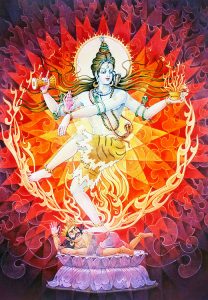
There are two main types of Indian dances ‘Tandav’ and ‘Bhalya’. After the deluge, Shiva performed the Tandav. Shiva is the creator of Dance and of the first 16 rhythmic syllabuses ever uttered, the Sanskrit language was born. With the sound of his tabor, Shiva spread art in all four directions.
Origin of the practice of yoga-synchronization of any two entities but usually it is related to mind & body as the two entities, commonly called “YOGA” is credited to him.
 One day his beautiful consort Parvatiji (daughter of King of Mountains), stealthily went behind Shivji and playfully placed her hands over his eyes. Suddenly darkness engulfed the whole world and all beings trembled in great fear as the Lord of the Universe had closed His eyes.
One day his beautiful consort Parvatiji (daughter of King of Mountains), stealthily went behind Shivji and playfully placed her hands over his eyes. Suddenly darkness engulfed the whole world and all beings trembled in great fear as the Lord of the Universe had closed His eyes.
Suddenly a massive tongue of flame leapt from the forehead of Shivji; a third eye appeared there and this gave light to the universe. Hence Lord Shiva is also called Tri-netra, Tri-ambaka, Tri-aksha or Tri-nayana because of his three eyes.
Lord Shiva, also called Tryambaka Deva (literally, “three-eyed Lord”), is always depicted as having three eyes: the Sun is his right eye, the moon the left eye and fire is his third eye.
The two eyes on the right and left indicate His activity in the physical world. The third eye in the center of the forehead symbolizes spiritual knowledge and power, and is thus called the eye of wisdom or knowledge. Like fire, the powerful gaze of Shiva’s third eye annihilates evil, and thus the evil-doers fear His third eye.
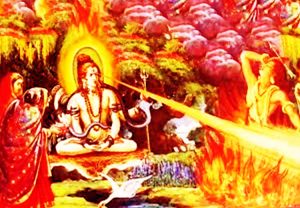
Kamdev, who was the image of desires, interrupted Shiva’s devout austerity in order to get him to fall in love with Parvati. Shiva was furious when He realized what was going on, and reduced Kama to ashes with the fire from his third eye.
Upon seeing his wife Rati’s sorrow, Shiva then allowed Kamdev to embody the invisible force of attraction and later he was allowed to be embodied again for a time as Krishna’s son. Kamdev is present in his invisible form everywhere.
In India, ladies often wear bindi on their forehead, in between their eyebrows. This is the place of the Third eye, known as the Ajna chakra, a concentration point of spiritual energy.
The bindi is considered to bestow spiritual comfort and protection against demons, bad luck, and other evil forces just like the third eye of Shiva.
 The crescent moon is shown on the side of the Lord’s head, serving as an ornament, and not as an integral part of His countenance. The monthly waxing and waning cycles of the moon symbolizes that mighty heavenly time cycle through which creation evolves from the beginning to the end. Since the Lord is the Eternal Reality, He is beyond Time. Thus, the crescent moon is only one of his ornaments, and not an integral part of Him.
The crescent moon is shown on the side of the Lord’s head, serving as an ornament, and not as an integral part of His countenance. The monthly waxing and waning cycles of the moon symbolizes that mighty heavenly time cycle through which creation evolves from the beginning to the end. Since the Lord is the Eternal Reality, He is beyond Time. Thus, the crescent moon is only one of his ornaments, and not an integral part of Him.
 The three-pronged trident shown next to or in the hand of, the Lord symbolises His three fundamental powers (Shakti) of will (Iccha), action (kriya) and knowledge (Gyan). The trident also symbolizes the Lord’s power to destroy evil and ignorance. A damaru ( one-handed drum), the small drum Lord Shiva holds in His hand, with the two sides separated from each other by a thin neck-like structure, symbolizes the two utterly dissimilar states of existence, the unmanifest and the manifest.
The three-pronged trident shown next to or in the hand of, the Lord symbolises His three fundamental powers (Shakti) of will (Iccha), action (kriya) and knowledge (Gyan). The trident also symbolizes the Lord’s power to destroy evil and ignorance. A damaru ( one-handed drum), the small drum Lord Shiva holds in His hand, with the two sides separated from each other by a thin neck-like structure, symbolizes the two utterly dissimilar states of existence, the unmanifest and the manifest.
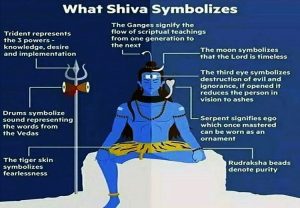 When a damru is vibrated, it produces dissimilar sounds, which are fused together by resonance to create one sound. The sound thus produced symbolises Nada, the cosmic sound of AUM, which can be heard during deep meditation. According to Hindu scriptures, Nada is the source of creation, just as it says “In the beginning was the Word”- and that world was AUM. One legend has it that Shiva gave the world its first syllabify, as the sounds of the Sanskrit language arose from his drumbeats, and His performance of that cosmic dance of Tandav.
When a damru is vibrated, it produces dissimilar sounds, which are fused together by resonance to create one sound. The sound thus produced symbolises Nada, the cosmic sound of AUM, which can be heard during deep meditation. According to Hindu scriptures, Nada is the source of creation, just as it says “In the beginning was the Word”- and that world was AUM. One legend has it that Shiva gave the world its first syllabify, as the sounds of the Sanskrit language arose from his drumbeats, and His performance of that cosmic dance of Tandav.
ARDHANARISHWAR
As Hindu Mythology tells us, Lord Shiva (Creator of the Universe) merged himself with Maa Parvati (the sustaining energy) in an eternal bond. This half-man-half–woman creation symbolizes the union of ‘Purush’ (power) and ‘Prakriti’ (nature/creation) demonstrating the eternal fusion of the masculine and feminine energies. This “dual” form of Lord Shiva is referred to as “Ardhanarishwar”. (“The Lord Who is Half Female”)
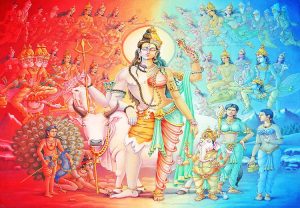
According to a legend, once Brahma and Vishnu, the two other Deities of the Masculine Triad, had an argument as to their supremacy. Brahma being the Creator declared himself to be more revered, while Vishnu, the Preserver, declared that he commanded more respect. Just then a colossal lingam, known as Jyotirlinga, blanketed in flames, appeared before them. Both Brahma and Vishnu were awestruck by its rapidly increasing size.
They forgot their quarrel and decided to determine its size. Vishnu assumed the form of a boar and dug down to the netherworld, and Brahma as a swan flew high in the sky. But both of them failed to accomplish their self-assumed tasks. Then, Shiva appeared out of that mighty lingam and stated that since he was the progenitor of them both,
He was supreme, and that henceforth He should be worshiped in his phallic form, the ‘lingam’, and not in an anthropomorphic form. The day Shiva appeared in the form of that Jyotirlinga was the 14th night of the waning moon of the month of Falgun. Hence, this day is celebrated as Mahashivratri, The day devoted to acknowledging the greatness of Lord Shiva.
 Shiva is conceived in his un manifest, invisible form as the Lingam. It is always accompanied by the Yoni, which represents Parvati, the female principle, surrounding the base of the Lingam and serving as its support. The Lingam represents the male creative energy of Shiva. Thus Shiva is the masculine energy.
Shiva is conceived in his un manifest, invisible form as the Lingam. It is always accompanied by the Yoni, which represents Parvati, the female principle, surrounding the base of the Lingam and serving as its support. The Lingam represents the male creative energy of Shiva. Thus Shiva is the masculine energy.
 The Shiva Linga is the holy symbol of Lord Shiva, considered sacred by the devotees of Lord Shiva. The word, ‘Lingum’ in Sanskrit means, ‘symbol’ or ‘significant object’. Shiva ‘Lingum’ therefore means ‘symbol of Lord Shiva’, and is therefore considered most sacred by devotees of Lord Shiva, known as Shaivaites.
The Shiva Linga is the holy symbol of Lord Shiva, considered sacred by the devotees of Lord Shiva. The word, ‘Lingum’ in Sanskrit means, ‘symbol’ or ‘significant object’. Shiva ‘Lingum’ therefore means ‘symbol of Lord Shiva’, and is therefore considered most sacred by devotees of Lord Shiva, known as Shaivaites.
 The Shiva Linga has been worshipped in Hinduism for millennia. The worship of the Shiva Linga is regarded as sacred and superior in the Shiva Mahapuran. This is because the form achieves two ends at once: it makes worship simple, while maintaining the truth that God does not have any definite form.
The Shiva Linga has been worshipped in Hinduism for millennia. The worship of the Shiva Linga is regarded as sacred and superior in the Shiva Mahapuran. This is because the form achieves two ends at once: it makes worship simple, while maintaining the truth that God does not have any definite form.
According to the Tantra, the Lingam is a symbol of Shiva’s phallus in spiritual form. They say, the lingam contains the soul-seed within which lies the essence of the entire cosmos. The lingam arises out of the base (Yoni) which represents Parvati according to some, or Vishnu, Brahma in female and neuter form, according to others.

 According to some scholars, the worship of the Shiva Linga in effect means worship of the reproductive function. For, they say, that the other meaning of the Sanskrit word ‘Linga’ is gender in general and phallus (the male reproductive organ) in particular. They believe that the base of the Lingam corresponds to the Yoni which means vagina or the female reproductive organ.
According to some scholars, the worship of the Shiva Linga in effect means worship of the reproductive function. For, they say, that the other meaning of the Sanskrit word ‘Linga’ is gender in general and phallus (the male reproductive organ) in particular. They believe that the base of the Lingam corresponds to the Yoni which means vagina or the female reproductive organ.
The correspondence of Linga and Yoni in a Shiva Linga is therefore interpreted as the representation of the process of copulation, which brings life to the world, but also necessitates the process of death as its corollary. Lord Shiva is Maha-Mrityunjaya, the Lord that is Victorious over Death, and so He can be worshipped by those who are afraid of death, or who are close to it in some way, to relieve their fears, and gain spiritual benefit.
AMARNATH
The Jyotirlinga represents Lord Shiva. Shiva manifested himself in the form of Jyoti (light) at twelve different places in India. They are: Kedarnath, Viswanath, Somnath, Mahakaleswar, Omkareshwar, Rameshwar, Mallikarjuna, Tryambakeshwar, Bhimashankar, Nageshwar, Baijnath and Grishneshwar.
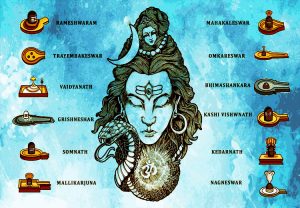
Even today, devotees are said to have His darshan in the form of jyoti at these places. One who recites these 12 names regularly in the morning and evening washes away all the sins committed in the previous seven births, and attains to all the powers and Siddhi’s. Mrityunjaya (literally translated as ‘triumphant over death’, is an aspect of Shiva worshipped as the overthrower of Death in the form manifested as the Hindu Lord of Death, Yama.
 The particular legend in question deals with the Sage Markandeya, who was fated to die at the age of sixteen. On account of that sage’s worship and devotion to Shiva, the Lord appeared at the moment Yama appeared to collect 16-year-old Markandeya, and knocked him down. Shiva has the power to liberate his devotees from the fear of death. Shiva is often worshipped as Mrutyunjay by the aged or ill, to ward off death as long as possible, and then mitigate its harshness when it does occur.
The particular legend in question deals with the Sage Markandeya, who was fated to die at the age of sixteen. On account of that sage’s worship and devotion to Shiva, the Lord appeared at the moment Yama appeared to collect 16-year-old Markandeya, and knocked him down. Shiva has the power to liberate his devotees from the fear of death. Shiva is often worshipped as Mrutyunjay by the aged or ill, to ward off death as long as possible, and then mitigate its harshness when it does occur.
 Shiva seated in the cremation ground signifies that he is the controller of death in the physical world. Since birth and death are cyclic, controlling one implies controlling the other. Thus, Lord Shiva is revered as the ultimate controller of birth and death in the phenomenal world.
Shiva seated in the cremation ground signifies that he is the controller of death in the physical world. Since birth and death are cyclic, controlling one implies controlling the other. Thus, Lord Shiva is revered as the ultimate controller of birth and death in the phenomenal world.
Shiva was married to Sati, the daughter of Daksha Prajapati. Daksha was not happy with the ascetic, ash-smeared Shiva, which is why he invited all his son-in-laws except Shiva to his great yagya. Sati (wife of Shiva) went to the yagya without an invitation from her family.
There she saw no place was being kept for Shiva. She could not bear this insult to her husband, and so threw away her life by jumping into the yagya fire. At this, the followers of Shiva became furious, and destroyed the yagya. Shiva, carrying the dead body of Sati over his shoulders, roamed around the world like a man in despair.
On seeing the distraught condition of Shiva, the other Gods got worried. Then, Lord Vishnu, with the help of his Sudarshan Chakra (a divine discus which swirls around his index finger), cut Sati’s dead body into numerous pieces and they fell off one by one, so that Shiva was relieved of his burden and soon returned to His normal state.
 Fifty one pieces of the dead body of Sati cut by Lord Vishnu fell all over India, and the place where they fell are known as Shaktipeeth. Each Shaktipeeth is connected with one of the body parts of Sati; for example, Kamakhya in Assam is where the Yoni (vulva) of Sati fell and is considered a very powerful centre of Shakti (female) worship.
Fifty one pieces of the dead body of Sati cut by Lord Vishnu fell all over India, and the place where they fell are known as Shaktipeeth. Each Shaktipeeth is connected with one of the body parts of Sati; for example, Kamakhya in Assam is where the Yoni (vulva) of Sati fell and is considered a very powerful centre of Shakti (female) worship.
Sati later reincarnated as Parvati in her next life, and remarried Shiva, never to part with him again. It is for this reason that Shiva, while monogamous, has not had two wives in reality, but the same soul in two incarnations.
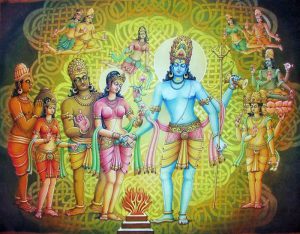
Sati’s rebirth took place at Giriraj Himalaya’s house. Her name was Parvati in the second birth. She eventually remarried Shiva and had two sons, Kartikeya, who was commander of the Gods, and Ganesha, who was worshipped by the Gods.
Shiva is universally acknowledged as God. He accepts everyone’s prayers whether those of a king or a poor person, evil or good. He is the honoured God of both Aryan and Dravid civilization of India. The disciples of Shiva are called Shaivite’s. It is said that on the 13th day of the bright lunar fortnight of the Hindu calendar, after 6 in the evening, falls a sacred hour called Pradosha, and if you worship Shiva at this time than one will attain the powers of the Universe.


